Prince Arthur, Duke of Connaught and Strathearn - Picture
More about World War 1
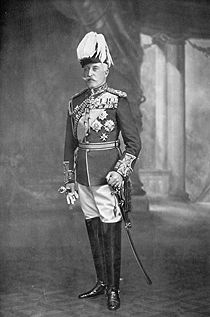
|
|
Prince Arthur, Duke of Connaught and Strathearn
Prince Arthur

Picture - Duke of Connaught and Strathearn
Tenure: 28 March 1884 - 28 March 1919
Predecessor: New creation
Successor: Alastair Windsor
:
Spouse: Princess Louise Margaret of Prussia
Issue:
: Margaret, Crown Princess of Sweden
Prince Arthur of Connaught
Princess Patricia of Connaught
Full name:
: Arthur William Patrick Albert
House: House of Windsor
House of Saxe-Coburg and Gotha
Father: Albert, Prince Consort
Mother: Queen Victoria
Born: 1 May 1850(1850-05-01)
Buckingham Palace, London
Died: 16 January 1942(1942-01-16) (aged 91)
Bagshot Park, Surrey
Burial: Royal Burial Ground
Prince Arthur, Duke of Connaught and Strathearn (Arthur William Patrick Albert; 1 May 1850 - 16 January 1942) was a member of the shared British and Saxe-Coburg and Gotha royal family who served as the Governor General of Canada, the 10th since Canadian Confederation.
Born the seventh child and third son of Queen Victoria and Prince Albert of Saxe-Coburg and Gotha, Arthur was educated by private tutors before at the age of 16 entering the Royal Military College at Woolwich. Upon graduation, he was commissioned as a lieutenant in the British Army, where he served for some 40 years, seeing service in various parts of the British Empire. During this time he was also created as a royal duke, becoming the Duke of Connaught and Strathearn, as well as the Earl of Sussex. He was appointed as Governor-General of Canada in 1911 by his nephew, King George V, on the recommendation of Prime Minister of the United Kingdom H. H. Asquith, to replace the Earl Grey as viceroy, occupying the post until succeeded by the Duke of Devonshire in 1916. Given his military service, the selection of Arthur proved to be prudent, as he acted as the King's, and thus the Canadian Commander-in-Chief's, representative through the first years of World War I.
After the end of his viceregal tenure, Arthur returned to the United Kingdom and there, as well as in India, performed various royal duties, while also again taking up military duties. Though he retired from public life in 1928, he continued to make his presence known in the army well into the Second World War, just before his death in 1942.
Early life
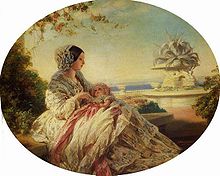
Picture - A painting of Queen Victoria with Prince Arthur by Franz Xaver Winterhalter
Arthur was born at Buckingham Palace on 1 May 1850, the seventh child and third son of Queen Victoria and Prince Albert. Baptised by the Archbishop of Canterbury, John Bird Sumner, on 22 June in the palace's private chapel, the Prince's godparents were the Crown Prince of Prussia; his great-uncle's sister-in-law, Princess Bernard of Saxe-Weimar-Eisenach (for whom his maternal grandmother the Duchess of Kent stood proxy); and the Duke of Wellington (with whom he shared his birthday and after whom he was named). As with his older brothers, Arthur received his early education from private tutors and it was reported that he became the Queen's favourite child.
Military service
It was at an early age that Arthur developed an interest in the army, and in 1866 he followed through on his military ambitions by enrolling at the Royal Military College at Woolwich, from where he graduated two years later and was commissioned as a lieutenant in the Corps of Royal Engineers on 18 June 1868. The Prince transferred to the Royal Regiment of Artillery on 2 November 1868 and, on 2 August 1869, to the Rifle Brigade, his father's own regiment, after which he conducted a long and distinguished career as an army officer, including service in South Africa, Canada in 1869, Ireland, Egypt in 1882, and in India from 1886 to 1890. It was in Canada that Arthur undertook a year's training with the Rifle Brigade and engaged in defending the Dominion from the Fenian Raids. During his service in Canada he was also entertained by Canadian society; amongst other activities, he attended an investiture ceremony in Montreal, was a guest at balls and gardern parties, and toured towns in Ontario and Quebec, all of which was documented in photographs that were sent back for the Queen to view. Of the Prince, Lady Lisgar, wife of then Governor General of Canada the Lord Lisgar, noted in a letter to Victoria that Canadians seemed hopeful Prince Arthur would one day return as governor general.
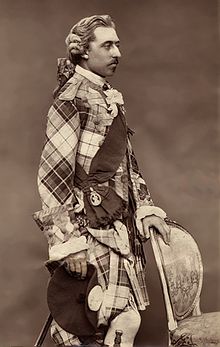
Picture - The Duke in traditional Scottish clothing, c. 1875 - 1880
On his mother's birthday in 1874, Arthur was created a royal peer, being titled as the Duke of Connaught and Strathearn and Earl of Sussex. Some years later, Arthur came into the direct line of succession to the Duchy of Saxe-Coburg and Gotha in Germany, upon the death in 1899 of his nephew, Prince Alfred of Edinburgh, the only son of his elder brother, Prince Alfred, Duke of Edinburgh. He decided, however, to renounce his own and his son's succession rights to the duchy, which then passed to his other nephew, Prince Charles Edward, the posthumous son of Prince Leopold, Duke of Albany.
On 13 March 1879, at St. George's Chapel in Windsor Castle, Arthur married Princess Louise Margaret of Prussia, the daughter of Prince Friedrich Charles and a grand-niece of the German Emperor, Arthur's godfather, Wilhelm I. The couple bore three children: Princess Margaret Victoria Charlotte Augusta Norah (born 15 January 1882), Prince Arthur Frederick Patrick Albert (born 13 January 1883), and Princess Victoria Patricia Helena Elizabeth (born 17 March 1886), who were all raised at the Connaughts' country home, Bagshot Park, in Surrey, and after 1900 at Clarence House, the Connaughts' London residence. Through his children's marriages, Arthur became the father-in-law of Crown Prince Gustaf Adolf of Sweden; Princess Alexandra, Duchess of Fife; and Sir Alexander Ramsay. Arthur's first two children predeceased him, however, Margaret while pregnant with his eighth grandchild. For many years, Arthur maintained a liaison with Leonie, Lady Leslie, sister of Jennie Churchill, while still remaining devoted to his wife.
Arthur was promoted to the honorary rank of colonel on 14 June 1871, as a substantive colonel on 29 May 1880, and on 1 April, 13 years later, was made a general. The Prince had hoped to succeed his first cousin once-removed, the elderly Prince George, Duke of Cambridge, as Commander-in-chief of the British Army, upon the latter's forced retirement in 1895. But this desire was denied to Arthur, and instead he was given, between 1893 and 1898, command of the southern district of Aldershot. On 26 June 1902 he was promoted to the post of field-marshal, and thereafter served in various important positions, including Commander-in-Chief of Ireland, from 1900 to 1904, and Inspector-General of the Forces, between 1904 and 1907.
At the same time, he continued to undertake royal duties beyond, or vaguely associated with, the army; in 1910, Arthur travelled aboard the Union-Castle Line ship Balmoral Castle to South Africa, to open the first parliament of the newly formed union, and in Johannesburg on 30 November he laid a commemorative stone at the Rand Regiments Memorial, dedicated to the British soldiers that died during the Second Boer War. As well, when his brother was obliged to resign the office upon his accession in 1901 as King Edward VII, Prince Arthur was elected as Grand Master of the United Grand Lodge of England and was subsequently re-elected as such an additional 37 times before 1939, when the Prince was nearly 90 years of age.
Governor generalship
It was announced on 6 March 1911 that George V had, by commission under the royal sign-manual and signet, approved the recommendation of his British prime minister, H.H. Asquith, to appoint Arthur as his representative. Though his brother-in-law, the Duke of Argyll, had previously served as the country's governor general, with his swearing-in on 13 October 1911, in the salon rouge of the parliament buildings of Quebec, Arthur became the first, and so far only, Governor General of Canada to be of the Blood Royal.
To Canada, Arthur brought with him his wife and his youngest daughter, the latter of which would become an extremely popular figure with Canadians. With the viceregal family, the Governor General travelled throughout the country, performing such ceremonial tasks as in 1917 laying at the newly rebuilt Centre Block on Parliament Hill the same cornerstone his older brother, the late King Edward VII, had set on 1 September 1860, when the original building was under construction. The Connaughts also made many improvements to the royal and viceroyal residence in Ottawa - Rideau Hall - during Arthur's term as governor general.
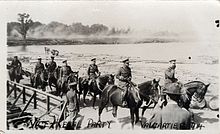
Picture - Prince Arthur and his viceregal party visit the Valcartier military base, 1914
In 1914, World War I broke out, with Canadians called to arms against Germany and Austria-Hungary. Arthur maintained a wider role in the empire - for instance, from 1912 until his death, serving as Colonel-in-Chief of the Cape Town Highlanders Regiment - but the Connaughts remained in Canada after the beginning of the global conflict, with Arthur emphasizing the need for military training and readiness for Canadian troops departing for war, and giving his name to Connaught Cup for the Royal North West Mounted Police, to encourage pistol marksmanship for recruits. He was also active in auxiliary war services and charities and conducted hospital visits. Though well intended, upon the outbreak of the war, Arthur immediately donned his field marshal's uniform and went, without advice or guidance from his ministers, to training grounds and barracks to address the troops and to see them off before their voyage to Europe. This was much to the chagrin of Prime Minister Robert Borden, who saw the Prince as overstepping constitutional conventions. Borden placed blame on the military secretary, Edward Stanton, but also opined that Arthur "laboured under the handicap of his position as a member of the Royal Family and never realized his limitations as Governor General." At the same time, the Duchess of Connaught worked for the Red Cross and other organizations to support the war cause. She was also Colonel-in-Chief of the Duchess of Connaught's Own Irish Canadian Rangers battalion, one of the regiments in the Canadian Expeditionary Force, and Princess Patricia also lent her name and support to the raising of a new Canadian army regiment - Princess Patricia's Canadian Light Infantry.
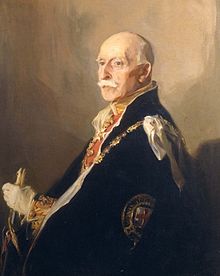
Picture - The Duke of Connaught and Strathearn in later life
Following the war, Arthur commissioned in memory of Canada's fallen a stained glass window which is located in St. Bartholomew's Church, next to Rideau Hall, and which the family attended regularly.
Later life
After his years in Canada, the Duke of Connaught and Strathearn held no similar public offices but undertook a number of public engagements. In 1921, he travelled to India, where he officially opened the new Central Legislative Assembly, Council of State, and Chamber of Princes. As president of the Boy Scouts Association and one of the Lord Baden-Powell's friends and admirers, he performed the official opening of the 3rd World Scout Jamboree at Arrowe Park.
The Duke also returned to military service and continued well into World War II, where he was seen as a grandfather figure by aspiring recruits. The Duchess, who had been ill during their years at Rideau Hall, died in March 1917, and Arthur mostly withdrew from public life in 1928; his last formal engagement was the opening of the Connaught Gardens in Sidmouth, Devon, on 3 November 1934. He died in 1942 at Bagshot Park, at the age of 91 years, 8 months and, 15 days, coincidentally exactly the same age at which his elder sister, Princess Louise, Dowager Duchess of Argyll, died, making them jointly the two longest-lived of Queen Victoria and Prince Albert's nine children. Prince Arthur also currently holds the record as the longest-lived male member of the British and then Commonwealth realms royal family.
Titles, styles, honours and arms
Titles and styles
Saxe-Coburg and Gotha
1 May 1850 - 14 July 1917: His Serene Highness Prince Arthur of Saxe-Coburg and Gotha, Duke of Saxony
United Kingdom
1 May 1850 - 24 May 1874: His Royal Highness the Prince Arthur
24 May 1874 - 13 October 1911: His Royal Highness the Duke of Connaught and Strathearn
13 October 1911 - 11 November 1916: His Royal Highness the Duke of Connaught and Strathearn, Governor General and Commander-in-Chief of the Militia and Naval Forces of Canada
11 November 1916 - 16 January 1942: His Royal Highness the Duke of Connaught and Strathearn
Arthur's style and title as governor general was, in full, and in English: His Royal Highness the Prince Arthur William Patrick Albert, Duke of Connaught and Strathearn, Earl of Sussex, Knight Companion of the Most Noble Order of the Garter, Extra Knight of the Most Ancient and Most Noble Order of the Thistle, Knight of the Most Illustrious Order of Saint Patrick, Knight Grand Cross of the Most Distinguished Order of Saint Michael and Saint George, Extra Knight Grand Commander of the Most Exalted Order of the Star of India, Knight Grand Commander of the Most Eminent Order of the Indian Empire, Knight Grand Cross of the Royal Victorian Order, Grand Master and Principal Knight Grand Cross of the Most Honourable Order of the Bath, Knight of the Order of the Black Eagle, Grand Cross of the Order of the Red Eagle, Governor General and Commander-in-Chief of the Militia and Naval Forces of Canada, General of the Militia of the United Kingdom of Great Britain and Ireland, and in French: Son Altesse Royale le prince Arthur William Patrick Albert, duc de Connaught et Strathearn, comte de Sussex, chevalier du nobilissime ordre de la Jarretix¨re, chevalier additionel du trx¨s ancien et trx¨s noble ordre du Chardon, chevalier du trx¨s illustre ordre de Saint-Patrick, chevalier grand-croix du trx¨s distingué ordre de Saint-Michel et Saint-George, chevalier grand commandeur additionel du plus haut ordre de l'x‰toile d'Inde, chevalier grand commandeur du plus éminent ordre de l'Empire des Indes, chevalier grand-croix de l'ordre royal de Victoria, chevalier grand-croix de l'excellentissime ordre de l'Empire britannique, grand max®tre et chevalier grand-croix du trx¨s honorable ordre du Bain, chevalier de l'ordre de l'Aigle noir, grand croix de l'ordre de l'Aigle rouge, gouverneur général et commandant en chef de la milice et des forces navales du Canada, général de la milice du Royaume-Uni de Grande-Bretagne et d'Irlande.
After King George V relinquished in 1917 the German titles belonging to both himself and his various cousins, Arthur's title remained the same, save for the removal of the references to Duke of Saxony and Prince of Saxe-Coburg and Gotha, as well as mention of his German honours, the Order of the Black Eagle and Order of the Red Eagle.
Honours
Orders
31 May 1867 - 16 January 1942: Knight Companion of the Most Noble Order of the Garter (KG)
1869 - 16 January 1942: Extra Knight of the Most Ancient and Most Noble Order of the Thistle (KT)
1869 - 16 January 1942: Knight of the Most Illustrious Order of Saint Patrick (KP)
1870 - 16 January 1942: Knight Grand Cross of the Most Distinguished Order of Saint Michael and Saint George (GCMG)
1870s-1888: Knight of Justice of the Sovereign and Illustrious Order of Saint John of Jerusalem, Anglia
1888 - 1894: Knight of Justice of the Order of the Hospital of Saint John of Jerusalem in England
1894 - 1910: Bailiff of Egle of the Order of the Hospital of Saint John of Jerusalem in England
1910 - 1926: Grand Prior of the Order of the Hospital of Saint John of Jerusalem in England
1926 - 1939: Grand Prior of the Venerable Order of the Hospital of Saint John of Jerusalem
1936 - 1939: Grand Prior of the Most Venerable Order of the Hospital of Saint John of Jerusalem
1939 - 1942: Bailiff Grand Cross of the Most Venerable Order of the Hospital of Saint John of Jerusalem
1 January 1877 - 16 January 1942: Extra Knight Grand Commander of the Most Exalted Order of the Star of India (GCSI)
17 November 1882 - 21 May 1898: Companion of the Military Division of the Most Honourable Order of the Bath (CB)
21 May 1898 - 16 January 1942: Knight Grand Cross of the Most Honourable Order of the Bath (GCB)
26 February 1901 - 16 January 1942: Great Master and Principal Knight Grand Cross of the Most Honourable Order of the Bath
1887 - 16 January 1942: Knight Grand Commander of the Most Eminent Order of the Indian Empire (GCIE)
1896 - 16 January 1942: Knight Grand Cross of the Royal Victorian Order (GCVO)
1917 - 16 January 1942: Knight Grand Cross of the Most Excellent Order of the British Empire (GBE)
Awards
n/a: Royal Victorian Chain
Decorations
1892: Volunteer Decoration (VD)
1934: Territorial Decoration (TD)
Medals
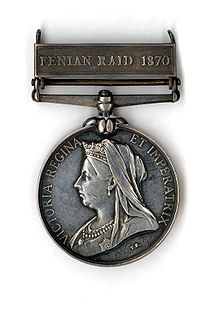
Picture - The medal awarded for participation in repelling the Fenian raids, presented by Queen Victoria in 1870
1870: Canada General Service Medal with FENIAN RAID 1870 Clasp
1877: South Africa Medal
1882: Egypt Medal with TEL-EL-KEBIR Clasp
1883: Long Service and Good Conduct Medal
1897: Queen Victoria Diamond Jubilee Medal
1902: King Edward VII Coronation Medal
1911: King George V Coronation Medal
1917: 1914 Star
1918: British War Medal
1918: Victory Medal
1935: King George V Silver Jubilee Medal
1937: King George VI Coronation Medal
Foreign honours
1873 - 14 July 1917: Knight of the Order of the Black Eagle
1873 - 14 July 1917: Grand Cross of the Order of the Red Eagle
November 1882 - 14 July 1917: Pour le Mérite
1882 - 16 January 1942: Member 2nd Class of the Order of the Medjidie
Order of the Golden Fleece (Spain)
Order of St Andrew (Russia)
Order of the Annunziata (Italy)
Order of the Elephant (Denmark)
Order of Osmanieh (Turkey)
Legion of Honour (France)
Order of the Chrysanthemum (Japan)
Order of the Seraphim (Sweden)
Order of the Tower and Sword (Portugal)
Order of Military Merit (Spain)
Grand Cross, Order of the Crown (Wx¼rttemberg)
Civil appointments
16 May 1871 - 16 January 1942: Privy Counsellor (PC)
10 January 1900: Privy Counsellor of Ireland
1910 - 1942: Master of the Corporation of Trinity House
13 October 1911 - 11 November 1916: Chief Scout for Canada
Ranger of Epping Forest
High Steward of Wokingham
Honorary military appointments
29 May 1880: Colonel-in-Chief, the Rifle Brigade
24 June 1883 - 1 May 1904: Colonel, Scots Guards
3 September 1901: Colonel-in-Chief, the Highland Light Infantry
1 May 1904 - 16 January 1942: Colonel, Grenadier Guards
3 June 1910 - 16 January 1942: Personal Aide-de-Camp to His Majesty the King (AdC(P))
13 October 1911 - 11 November 1916: Colonel of the Regiment of the Governor General's Horse Guards
13 October 1911 - 11 November 1916: Colonel of the Regiment of the Governor General's Foot Guards
13 October 1911 - 11 November 1916: Colonel of the Regiment of the Canadian Grenadier Guards
Honorific eponyms
Regiments
6th Duke of Connaught's Own Lancers (Watson's Horse)
31st Duke of Connaught's Own Lancers
7th (Duke of Connaught's Own) Rajputs
129th Duke of Connaught's Own Baluchis
Awards
Canada: Connaught Cup
Canada: Connaught Cup (later Canadian National Challenge Cup
Geographic locations
Northwest Territories: Prince Patrick Island
Alberta: Connaught
British Columbia: Connaught Creek, Glacier National Park
British Columbia: Connaught Heights, New Westminster
British Columbia: Connaught Hill, Prince George
England: Connaught Park Housing Estate, Bagshot
England: Connaught Water, Epping Forest
India: Connaught Circus, New Delhi
India: Connaught Place, New Delhi
Ontario: Connaught
Ontario: Port Arthur (in 1970 incorporated into Thunder Bay)
Ontario: Connaught Square, Thunder Bay
Buildings
Alberta: Connaught Armoury, Edmonton
England: Connaught Hall, University of London, London
England: Connaught Hall, Worthing
England: Connaught Theatre, Worthing
England: Connaught Hotel, London
Newfoundland and Labrador: Connaught Hall, Botwood
New South Wales: The Connaught, Sydney
Ontario: Connaught Building, Ottawa
Ontario: Connaught National Army Cadet Training Centre, Ottawa
Quebec: Connaught Park Racetrack, Aylmer
Schools
British Columbia: Connaught Hill Public Elementary School, Prince George
British Columbia: Connaught Public Elementary School, New Westminster
England: Connaught Junior School, Bagshot
England: Connaught School for Girls, Leytonstone
Ontario: Connaught Public School, Collingwood
Ontario: Connaught Public School, Ottawa
Saskatchewan: Connaught Public School, Regina
Highways, roads, and bridges
British Columbia: Connaught Tunnel
Hong Kong: Connaught Road
Ontario: Prince Arthur Avenue, Toronto
Quebec: Prince Arthur Street, Montreal
Saskatchewan: Connaught Avenue, Moose Jaw
Events
Ontario: Connaught Cup Stakes, Woodbine Racetrack, Toronto
Arms
Ancestry
British prince
Royal Dukedoms in the United Kingdom
Scouting Round the World, John S. Wilson, first edition, Blandford Press 1959 p. 81
More aircraft.
Source: WikiPedia